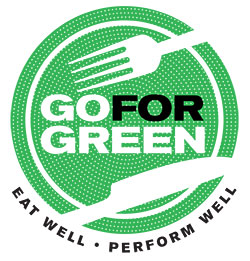'Go For Green' where you eat, work, play and shop
Go For Green gives green, yellow or red codes to foods and beverages based on their nutritional quality. "Green-coded" foods, which are highest in nutrients such as vitamins, minerals, fiber, protein and "good" fats, are a "go."
 With all the options at your local commissary it can be hard to know what is best. Use the Go For Green (G4G) Guide to make it easier.
With all the options at your local commissary it can be hard to know what is best. Use the Go For Green (G4G) Guide to make it easier.
Go For Green was originally developed for military dining facilities as a quick and easy way to identify healthier food and beverage choices and you can follow the same guidelines when shopping at your commissary.
Want to slim your waistline? Enhance physical fitness? Have more energy? Feel more alert and focused? Improve your health? Go For Green can help you and your family. Use the G4G Guide at the commissary to shop your way to health.
How to make your shopping cart more 'Green'
A good rule of thumb is to fill at least half of your shopping cart or basket with Green-coded foods. Shopping the perimeter is a great way to shop for nutritious foods.
- Start in the produce section, where healthy options are endless. Green-coded foods abound here because fruits and vegetables are high in nutrients, which add health-boosting benefits to any meal or snack. Choose a variety of your favorite fruits and veggies. Limit veggies that are fried or in cheese or cream sauce and fruits in heavy syrup or coated in sugar (chocolate, yogurt, etc.). Picky vegetable eater at home? Let them in on the fun, making it a family goal to try one new vegetable a month. Involving your family can help them become more interested in trying new foods.
- Further down, you'll see the dairy aisle and the meat counter. At the meat counter, look for fish, shellfish, chicken and turkey breast without the skin, pork tenderloin, ground poultry, and 90 percent lean beef. Good dairy choices include plain, low-fat yogurt or cottage cheese and unsweetened skim or 1-percent milk. All these are Green-coded lean protein sources that help build a healthy meal.
- Next up, the bread aisle. There are rows of options. What should you choose? Green-coded options are whole-grain baked goods that have less processing and are high in fiber, vitamins and minerals. Choose whole-grain breads, bagels, rolls and English muffins with at least 3 grams of fiber, too.
- Don't overlook the center aisles, as you go through the commissary. You can find more good sources of Green-coded foods here. Canned tuna in water and canned or dried beans and lentils are shelf-stable proteins that add variety to lunch and dinner meals. Look for whole-grain, low-sugar varieties of cereal with less than 10 grams of sugar and at least 3 grams of fiber. Grains such as brown rice, wild rice, bulgur, oats, quinoa and barley are minimally processed and packed with nutrients. Leave these aisles with naturally healthful and tasty ingredients and add your own herbs, spices and seasonings.
- Also look here for heart-healthy fats and oils, which provide flavor and texture and help keep you feeling full. The key is choosing the right ones and keeping the portions small. Oils such as olive, canola, safflower and sunflower are Green-coded fats that provide flavor to numerous recipes. Salad dressings (oil-based), nuts and seeds are perfect accompaniments to salads, side dishes and main meals.
- Finally, find healthy, economical Green-coded choices in the freezer aisles. Frozen fruits and vegetables can provide just as many nutrients as fresh in pre-washed, pre-cut versions. Frozen plain (unbreaded) fish, chicken and bean burgers can make meal preparation quick during a busy week. You can even find fully cooked brown rice, oatmeal and other whole grains that only require reheating.
Green-coded foods are whole foods that have the least processing and are naturally packed with nutrients. Next time you're in the commissary, try to fill more of your cart or basket with Green-coded options. Your mind and body will thank you.
Learn more about building a healthy meal with Go For Green.
(Katie Kirkpatrick is a nutritionist with CHAMP, the Consortium for Health and Military Performance)
